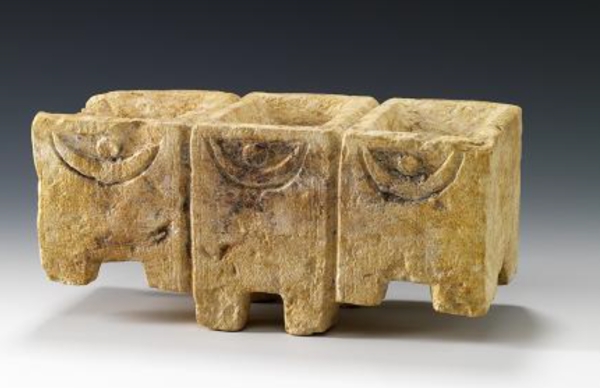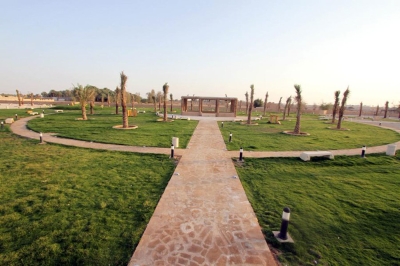
A Sandstone Censer is a well-carved and finely polished censer made of sandstone, discovered in the archaeological Qaryat al-Faw, at the intersection of Wadi ad-Dawasir and the Tuwaiq Mountains range, southeast of Wadi ad-Dawasir Governorate, Riyadh Province, the Kingdom of Saudi Arabia.
Description of the censer
The censer consists of three cubic censers carved from a single block of sandstone. A shallow carved groove separates each censer, creating the appearance of three distinct units. Each censer features a square-shaped shallow basin with slanted inner walls. Additionally, each censer is supported by four square legs, one at each corner. The front face of each censer has a semi-circular recessed carving, positioned beneath a raised crescent. At the center of the crescent, there is a raised solid circular relief. Some of the upper edges of the basins show signs of erosion due to impact with solid objects. The lower sections and legs are adorned with shallow intersecting diagonal grooves, while the other faces feature horizontal and vertical grooves forming a shallow grid-like pattern.
Dimensions of the censer.
Length: twenty-nine cm.
Width: 11.5 cm.
Height: thirteen cm.
Incense compartment depth: 2.5 cm
Date of the censer
The censer dates back to the period between the third century BCE and the third century CE and was used for burning incense.
It is exhibited at the Museum of the Department of Archaeology at King Saud University in Riyadh. The censer is part of the discoveries made by Saudi archaeologists and scientific expeditions, resulting from archaeological survey and excavation efforts carried out by the Saudi antiquities and museums sector over the years. The sandstone censer is cataloged under the number 10 F 22.
The censer at the Louvre Museum
The censer was among the artifacts selected for display in the Saudi Archeological Masterpieces Through the Ages Exhibition, held at the Louvre Museum in the French capital, Paris, in 2010. The exhibition featured three hundred artifacts of various materials and periods, all original pieces from different regions of Saudi Arabia. These artifacts were classified into three historical categories: Prehistoric artifacts, pre-Islamic artifacts, and Islamic-era artifacts.
Related quizzes
Related articles

